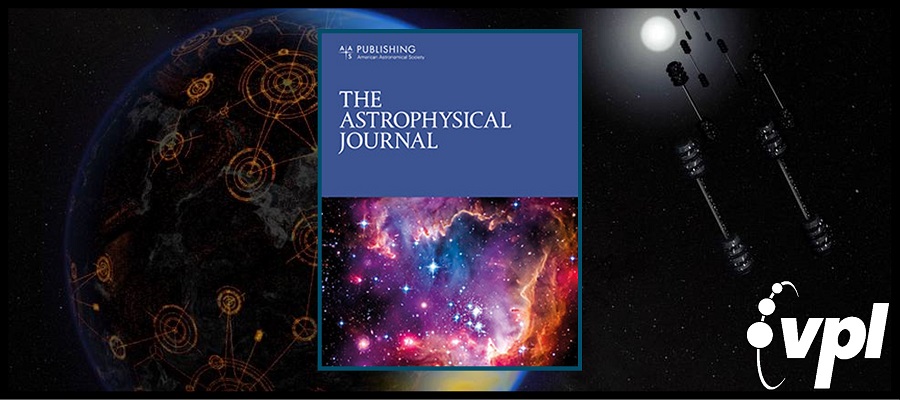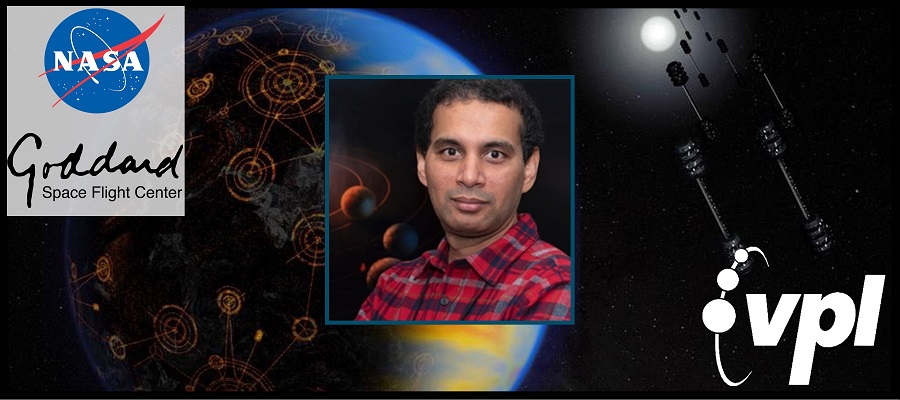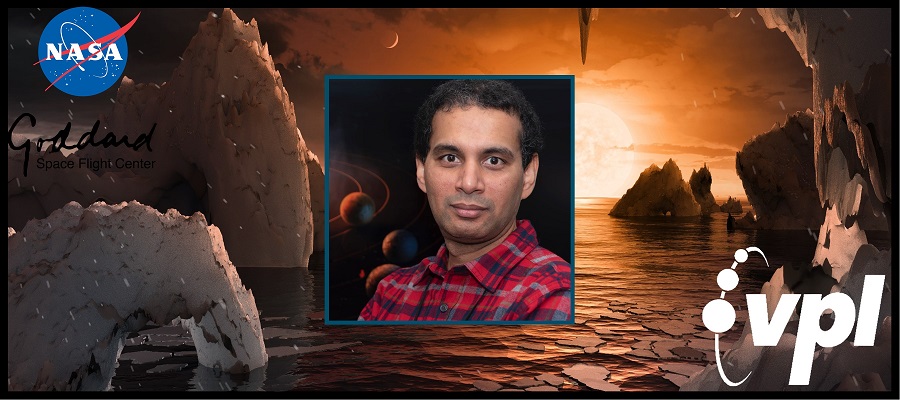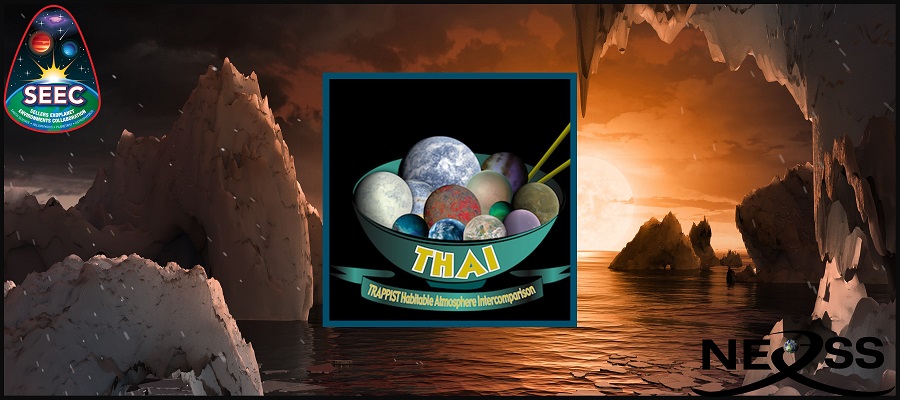VPL Team members Ravi Kopparapu, Giada Arney, Jacob Haqq-Misra, and Jacob Lustig-Yaeger, recently submitted a new study for publication exploring…
We present the occurrence rates for rocky planets in the habitable zones (HZs) of main-sequence dwarf stars based on the Kepler DR25 planet candidate catalog and Gaia-based stellar properties. We provide the first analysis in terms of star-dependent instellation flux, which allows us to track HZ planets. We define ?? as the HZ occurrence of planets with radii between 0.5 and 1.5 R? orbiting stars with effective temperatures between 4800 and 6300 K. We find that ?? for the conservative HZ is between ${0.37}_{-0.21}^{+0.48}$ (errors reflect 68% credible intervals) and ${0.60}_{-0.36}^{+0.90}$ planets per star, while the optimistic HZ occurrence is between ${0.58}_{-0.33}^{+0.73}$ and ${0.88}_{-0.51}^{+1.28}$ planets per star. These bounds reflect two extreme assumptions about the extrapolation of completeness beyond orbital periods where DR25 completeness data are available. The large uncertainties are due to the small number of detected small HZ planets. We find similar occurrence rates between using Poisson likelihood Bayesian analysis and using Approximate Bayesian Computation. Our results are corrected for catalog completeness and reliability. Both completeness and the planet occurrence rate are dependent on stellar effective temperature. We also present occurrence rates for various stellar populations and planet size ranges. We estimate with 95% confidence that, on average, the nearest HZ planet around G and K dwarfs is ~6 pc away and there are ~4 HZ rocky planets around G and K dwarfs within 10 pc of the Sun.
VPL scientist Dr. Ravi Kopparapu was recently awarded the NASA Exceptional Scientific Achievement Medal! NASA states: “This prestigious NASA medal…
VPL Scientist Dr. Ravi Kopparapu (NASA GSFC) was recently featured on the Ask an Astrobiologist program! Dr. Ravi Kopparapu is…
The NASA Nexus for Exoplanet Systems Science (NExSS) and Sellers Exoplanet Environments Collaboration recently hosted the TRAPPIST Habitable Atmospheres Intercomparison…
Here we use a 3‐D climate system model to study the habitability of Earth‐like planets orbiting in circumbinary systems. In the most extreme cases, Earth‐like planets in circumbinary systems could experience variations in the incident stellar flux of up to ~50% on ~100‐day timescales. However, we find that Earth‐like planets, having abundant surface liquid water, are generally effective at buffering against these time‐dependent changes in the stellar irradiation due to the high thermal inertia of oceans compared with the relatively short periods of circumbinary‐driven variations in the received stellar flux.
We present self-consistent three-dimensional climate simulations of possible habitable states for the newly discovered habitable-zone Earth-sized planet TOI-700 d. We explore a variety of atmospheric compositions, pressures, and rotation states for both ocean-covered and completely desiccated planets in order to assess the planet’s potential for habitability. For all 20 of our simulated cases, we use our climate model outputs to synthesize transmission spectra, combined-light spectra, and integrated broadband phase curves. These climatologically informed observables will help the community assess the technological capabilities necessary for future characterization of this planetas well as similar transiting planets discovered in the futureand will provide a guide for distinguishing possible climate states if one day we do obtain sensitive spectral observations of a habitable planet around an M star. We find that TOI-700 d is a strong candidate for a habitable world and can potentially maintain temperate surface conditions under a wide variety of atmospheric compositions. Unfortunately, the spectral feature depths from the resulting transmission spectra and the peak flux and variations from our synthesized phase curves for TOI-700 d do not exceed 10 ppm. This will likely prohibit the James Webb Space Telescope from characterizing its atmosphere; however, this motivates the community to invest in future instrumentation that perhaps can one day reveal the true nature of TOI-700 d and to continue to search for similar planets around less distant stars.
We report on the validation of two planets orbiting the nearby (36pc) M2 dwarf TOI-1266 observed by the TESS mission. The inner planet is sub-Neptune-sized (R=2.46±0.08R⊕) with an orbital period of 10.9 days. The outer planet has a radius of 1.67+0.09−0.11R⊕ and resides in the exoplanet Radius Valley—the transition region between rocky and gaseous planets. With an orbital period of 18.8 days, the outer planet receives an insolation flux of 2.4 times that of Earth, similar to the insolation of Venus.
The search for spectroscopic biosignatures with the next generation of space telescopes could provide observational constraints on the abundance of exoplanets with signs of life. An extension of this spectroscopic characterization of exoplanets is the search for observational evidence of technology, known as technosignatures. Current mission concepts that would observe biosignatures from ultraviolet to near-infrared wavelengths could place upper limits on the fraction of planets in the Galaxy that host life, although such missions tend to have relatively limited capabilities of constraining the prevalence of technosignatures at mid-infrared wavelengths. Yet searching for technosignatures alongside biosignatures would provide important knowledge about the future of our civilization. If planets with technosignatures are abundant, then we can increase our confidence that the hardest step in planetary evolutionthe Great Filteris probably in our past. But if we find that life is commonplace while technosignatures are absent, then this would increase the likelihood that the Great Filter awaits to challenge us in the future.
Robust atmospheric and radiative transfer modeling will be required to properly interpret reflected-light and thermal emission spectra of terrestrial exoplanets. This will help break observational degeneracies between the numerous atmospheric, planetary, and stellar factors that drive planetary climate. Here, we simulate the climates of earthlike worlds around the Sun with increasingly slow rotation periods, from earthlike to fully Sun-synchronous, using the ROCKE-3D general circulation model. We then provide these results as input to the Spectral Planet Model, which employs the Spectral Mapping Atmospheric Radiative Transfer model to simulate the spectra of a planet as it would be observed from a future space-based telescope. We find that the primary observable effects of slowing planetary rotation rate are the altered cloud distributions, altitudes, and opacities that subsequently drive many changes to the spectra by altering the absorption band depths of biologically relevant gas species (e.g., ${{rm{H}}}_{2}{rm{O}}$, ${{rm{O}}}_{2}$, and ${{rm{O}}}_{3}$). We also identify a potentially diagnostic feature of synchronously rotating worlds in mid-infrared ${{rm{H}}}_{2}{rm{O}}$ absorption/emission lines.
The search for water-rich Earth-sized exoplanets around low-mass stars is rapidly gaining attention because they represent the best opportunity to characterize habitable planets in the near future. Understanding the atmospheres of these planets and determining the optimal strategy for characterizing them through transmission spectroscopy with our upcoming instrumentation is essential in order to constrain their environments. For this study, we present simulated transmission spectra of tidally locked Earth-sized ocean-covered planets around late-M to mid-K stellar spectral types, utilizing the results of general circulation models previously published by Kopparapu et al. as inputs for our radiative transfer calculations performed using NASA’s Planetary Spectrum Generator (psg.gsfc.nasa.gov). We identify trends in the depth of H2O spectral features as a function of planet surface temperature and rotation rate. These trends allow us to calculate the exposure times necessary to detect water vapor in the atmospheres of aquaplanets through transmission spectroscopy with the upcoming James Webb Space Telescope as well as several future flagship space telescope concepts under consideration (the Large UV Optical Infrared Surveyor and the Origins Space Telescope) for a target list constructed from the Transiting Exoplanet Survey Satellite (TESS) Input Catalog (TIC). Our calculations reveal that transmission spectra for water-rich Earth-sized planets around low-mass stars will be dominated by clouds, with spectral features <20 ppm, and only a small subset of TIC stars would allow for the characterization of an ocean planet in the habitable zone. We thus present a careful prioritization of targets that are most amenable to follow-up characterizations with next-generation instrumentation, in order to assist the community in efficiently utilizing precious telescope time.
The TRAPPIST-1 system, consisting of an ultracool host star having seven known Earth-sized planets, will be a prime target for atmospheric characterization with the James Webb Space Telescope (JWST). However, the detectability of atmospheric molecular species may be severely impacted by the presence of clouds and/or hazes. In this work, we perform 3D general circulation model (GCM) simulations with the LMD-G model supplemented by 1D photochemistry simulations at the terminator with the Atmos model to simulate several possible atmospheres for TRAPPIST-1e, 1f, and 1g: (1) modern Earth, (2) Archean Earth, and (3) CO2-rich atmospheres. The JWST synthetic transit spectra were computed using the GSFC Planetary Spectrum Generator. We find that the TRAPPIST-1e, 1f, and 1g atmospheres, with clouds and/or hazes, could be detected using JWST’s NIRSpec Prism from the CO2 absorption line at 4.3 ?m in less than 15 transits at 3? or less than 35 transits at 5?. However, our analysis suggests that other gases would require hundreds (or thousands) of transits to be detectable. We also find that H2O, mostly confined in the lower atmosphere, is very challenging to detect for these planets or similar systems if the planets’ atmospheres are not in a moist greenhouse state. This result demonstrates that the use of GCMs, self-consistently taking into account the effect of clouds and subsaturation, is crucial to evaluate the detectability of atmospheric molecules of interest, as well as for interpreting future detections in a more global (and thus robust and relevant) approach.
Transit spectroscopy of terrestrial planets around nearby M dwarfs will be a primary goal of space missions in coming decades. Three-dimensional climate modeling has shown that slow-synchronous rotating terrestrial planets may develop thick clouds at the substellar point, increasing the albedo. For M dwarfs with T eff > 3000 K, such planets at the inner habitable zone (IHZ) have been shown to retain moist greenhouse conditions, with enhanced stratospheric water vapor (fH 2O > 10?3) and low Earth-like surface temperatures. However, M dwarfs also possess strong UV activity, which may effectively photolyze stratospheric H2O. Prior modeling efforts have not included the impact of high stellar UV activity on the H2O. Here, we employ a 1D photochemical model with varied stellar UV, to assess whether H2O destruction driven by high stellar UV would affect its detectability in transmission spectroscopy. Temperature and water vapor profiles are taken from published 3D climate model simulations for an IHZ Earth-sized planet around a 3300 K M dwarf with an N2H2O atmosphere; they serve as self-consistent input profiles for the 1D model. We explore additional chemical complexity within the 1D model by introducing other species into the atmosphere. We find that as long as the atmosphere is well-mixed up to 1 mbar, UV activity appears to not impact detectability of H2O in the transmission spectrum. The strongest H2O features occur in the James Webb Space Telescope MIRI instrument wavelength range and are comparable to the estimated systematic noise floor of ~50 ppm.
Planets that revolve around a binary pair of stars are known as circumbinary planets. The orbital motion of the stars around their center of mass causes a periodic variation in the total instellation incident upon a circumbinary planet. This study uses both an analytic and numerical energy balance model to calculate the extent to which this effect can drive changes in surface temperature on circumbinary terrestrial planets. We show that the amplitude of the temperature variation is largely constrained by the effective heat capacity, which corresponds to the ocean?to?land ratio on the planet. Planets with large ocean fractions should experience only modest warming and cooling of only a few degrees, which suggests that habitability cannot be precluded for such circumbinary planets. Planets with large land fractions that experience extreme periodic forcing could be prone to changes in temperature of tens of degrees or more, which could drive more extreme climate changes that inhibit continuously habitable conditions.
Habitability is a measure of an environment’s potential to support life, and a habitable exoplanet supports liquid water on its surface. However, a planet’s success in maintaining liquid water on its surface is the end result of a complex set of interactions between planetary, stellar, planetary system and even Galactic characteristics and processes, operating over the planet’s lifetime. In this chapter, we describe how we can now determine which exoplanets are most likely to be terrestrial, and the research needed to help define the habitable zone under different assumptions and planetary conditions. We then move beyond the habitable zone concept to explore a new framework that looks at far more characteristics and processes, and provide a comprehensive survey of their impacts on a planet’s ability to acquire and maintain habitability over time. We are now entering an exciting era of terrestiral exoplanet atmospheric characterization, where initial observations to characterize planetary composition and constrain atmospheres is already underway, with more powerful observing capabilities planned for the near and far future. Understanding the processes that affect the habitability of a planet will guide us in discovering habitable, and potentially inhabited, planets.
We use a one-dimensional (1D) cloud-free climate model to estimate habitable zone (HZ) boundaries for terrestrial planets of masses 0.1 ME and 5 ME around circumbinary stars of various spectral type combinations. Specifically, we consider binary systems with host spectral types F-F, F-G, F-K, F-M, G-G, G-K, G-M, K-K, K-M and M-M. Scaling the background N2 atmospheric pressure with the radius of the planet, we find that the inner edge of the HZ moves inwards toward the star for 5 ME compared to 0.1 ME planets for all spectral types. This is because the water-vapor column depth is smaller for larger planets and higher temperatures are needed before water vapor completely dominates the outgoing longwave radiation. The outer edge of the HZ changes little due to competing effects of the albedo and greenhouse effect. While these results are broadly consistent with the trend of single star HZ results for different mass planets, there are significant differences between single star and binary star systems for the inner edge of the HZ. Interesting combinations of stellar pairs from our 1D model results can be used to explore for in-depth climate studies with 3D climate models. We identify a common HZ stellar flux domain for all circumbinary spectral types.
Orbital phase-dependent variations in thermal emission and reflected stellar energy spectra can provide meaningful constraints on the climate states of terrestrial extrasolar planets orbiting M dwarf stars. Spatial distributions of water vapor, clouds, and surface ice are controlled by climate. In turn, water, in each of its thermodynamic phases, imposes significant modulations to thermal and reflected planetary spectra. Here we explore these characteristic spectral signals, based on 3D climate simulations of Earth-sized aquaplanets orbiting M dwarf stars near the habitable zone. By using 3D models, we can self-consistently predict surface temperatures and the location of water vapor, clouds, and surface ice in the climate system. Habitable zone planets in M dwarf systems are expected to be in synchronous rotation with their host star and thus present distinct differences in emitted and reflected energy fluxes depending on the observed hemisphere. Here we illustrate that icy, temperate, and incipient runaway greenhouse climate states exhibit phase-dependent spectral signals that enable their characterization.
Orbital phase-dependent variations in thermal emission and reflected stellar energy spectra can provide meaningful constraints on the climate states of terrestrial extrasolar planets orbiting M dwarf stars. Spatial distributions of water vapor, clouds, and surface ice are controlled by climate. In turn, water, in each of its thermodynamic phases, imposes significant modulations to thermal and reflected planetary spectra. Here we explore these characteristic spectral signals, based on 3D climate simulations of Earth-sized aquaplanets orbiting M dwarf stars near the habitable zone. By using 3D models, we can self-consistently predict surface temperatures and the location of water vapor, clouds, and surface ice in the climate system. Habitable zone planets in M dwarf systems are expected to be in synchronous rotation with their host star and thus present distinct differences in emitted and reflected energy fluxes depending on the observed hemisphere. Here we illustrate that icy, temperate, and incipient runaway greenhouse climate states exhibit phase-dependent spectral signals that enable their characterization.
Terrestrial planets at the inner edge of the habitable zone (HZ) of late-K and M-dwarf stars are expected to be in synchronous rotation, as a consequence of strong tidal interactions with their host stars. Previous global climate model (GCM) studies have shown that, for slowly rotating planets, strong convection at the substellar point can create optically thick water clouds, increasing the planetary albedo, and thus stabilizing the climate against a thermal runaway. However these studies did not use self-consistent orbital/rotational periods for synchronously rotating planets placed at different distances from the host star. Here we provide new estimates of the inner edge of the HZ for synchronously rotating terrestrial planets around late-K and M-dwarf stars using a 3D Earth-analog GCM with self-consistent relationships between stellar metallicity, stellar effective temperature, and the planetary orbital/rotational period.
Advancements in our understanding of exoplanetary atmospheres, from massive gas giants down to rocky worlds, depend on the constructive challenges between observations and models. We are now on a clear trajectory for improvements in exoplanet observations that will revolutionize our ability to characterize the atmospheric structure, composition, and circulation of these worlds. These improvements stem from significant investments in new missions and facilities, such as JWST and the several planned ground-based extremely large telescopes. However, while exoplanet science currently has a wide range of sophisticated models that can be applied to the tide of forthcoming observations, the trajectory for preparing these models for the upcoming observational challenges is unclear. Thus, our ability to maximize the insights gained from the next generation of observatories is not certain.
Earth-like planets within the liquid water habitable zone of M-type stars may evolve into synchronous rotators. On these planets, the substellar hemisphere experiences perpetual daylight while the opposing antistellar hemisphere experiences perpetual darkness. Because the night-side hemisphere has no direct source of energy, the air over this side of the planet is prone to freeze out and deposit on the surface, which could result in atmospheric collapse. However, general circulation models (GCMs) have shown that atmospheric dynamics can counteract this problem and provide sufficient energy transport to the antistellar side. Here, we use an idealized GCM to consider the impact of geothermal heating on the habitability of synchronously rotating planets.
National Aeronautics and Space Administration’s (NASA) Kepler Space Telescope has detected over 3,000 planet candidates, about a dozen of which are probably rocky planets within the liquid-water habitable zones of their parent stars. Climate-modeling calculations discussed here shed light on the width of that zone. Within the next several years, NASA may obtain spectra of nearby transiting Earth-sized planets around M stars, using its James Webb Space Telescope. NASA hopes to build an even more capable space telescope to perform direct imaging of Earth-like exoplanets and take spectra of their atmospheres. Once data are obtained from either of these missions, correct interpretation of possible biomarker gases will become critical. We discuss here how those interpretations might be made.
The presence of valleys on ancient terrains of Mars suggests that liquid water flowed on the martian surface 3.8 Gyr ago or before. The above-freezing temperatures required to explain valley formation could have been transient, in response to the frequent large meteorite impacts on early Mars, or they could have been caused by long-lived greenhouse warming. Climate models that consider only the greenhouse gases carbon dioxide and water have been unable to recreate warm surface conditions, given the lower solar luminosity at that time. Here we use a one-dimensional climate model to demonstrate that an atmosphere containing 1.3–4 bar of CO2 and water, in addition to 5–20% H2, could have raised the mean surface temperature of early Mars above the freezing point of water. Vigorous volcanic outgassing from a highly reduced early martian mantle is expected to provide sufficient atmospheric H2 and CO2—the latter from the photochemical oxidation of outgassed CH4 and CO—to form a CO2 and H2 greenhouse. Such a dense early martian atmosphere is consistent with independent estimates of surface pressure based on cratering data.
If mutual gravitational scattering among exoplanets occurs, then it may produce unique orbital properties. For example, two-planet systems that lie near the boundary between circulation and libration of their periapses could result if planet-planet scattering ejected a former third planet quickly, leaving one planet on an eccentric orbit and the other on a circular orbit. We first improve upon previous work that examined the apsidal behavior of known multiplanet systems by doubling the sample size and including observational uncertainties. This analysis recovers previous results that demonstrated that many systems lay on the apsidal boundary between libration and circulation. We then performed over 12,000 three-dimensional N-body simulations of hypothetical three-body systems that are unstable, but stabilize to two-body systems after an ejection. Using these synthetic two-planet systems, we test the planet-planet scattering hypothesis by comparing their apsidal behavior, over a range of viewing angles, to that of the observed systems and find that they are statistically consistent regardless of the multiplicity of the observed systems. Finally, we combine our results with previous studies to show that, from the sampled cases, the most likely planetary mass function prior to planet-planet scattering follows a power law with index -1.1. We find that this pre-scattering mass function predicts a mutual inclination frequency distribution that follows an exponential function with an index between -0.06 and -0.1.




